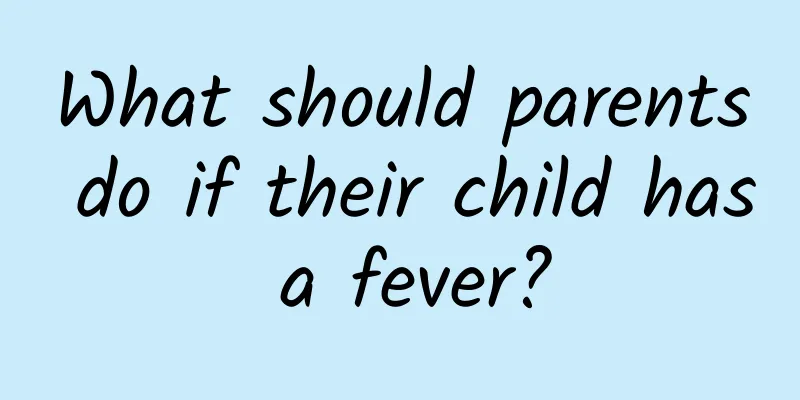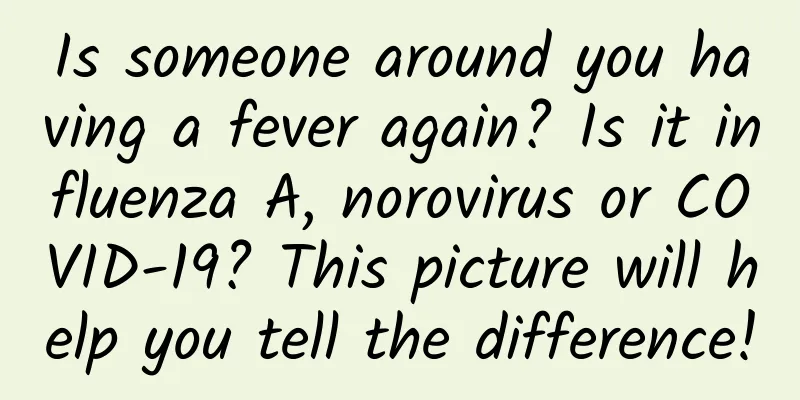What should parents do if their child has a fever?

|
At a time when respiratory diseases are rampant, children's fever has become the most common symptom that worries parents. When faced with a child's fever, whether to go to the hospital, when to go to the hospital, and what to do if going to the hospital or not are all practical issues that parents face. Written by Li Changqing (Doctor of Medicine, practicing physician in the United States) As expected by the medical community, this winter, various respiratory diseases have swept across China at a more frenzied pace than in previous years, and major hospitals, especially children's hospitals and pediatric departments of large hospitals, have been under increasing pressure. We have seen many reports that patients have to wait in line for hundreds or even thousands of emergency rooms, wait for hours, or even have to stay overnight in the hospital. Parents of sick children often face a question: Should they send their children to the hospital? This concern is not only about the long queues, but also about the risk of "cross infection". During the respiratory disease epidemic season, the most common reason for children to be sent to the hospital is fever. This article takes fever as an example to discuss when to send children to the hospital and how to properly handle children's illness at home if they do not go to the hospital. Most fevers do not require medical attention Everyone has had a fever in their life, and it is even more common for children. Viruses and bacteria are widely present around us. Although they are invisible and intangible, fever is the body's tangible response to them. When viruses and bacteria invade the human body, white blood cells will become crazy death squads, killing these invading pathogens, and in the process they will release some substances that cause fever. Bacteria and viruses themselves can also increase body temperature by affecting the body's regulatory center. After most viruses are cleared by the human body, the immune system will produce targeted antibodies, and the next time the virus enters the body, it can be efficiently cleared, and many people will no longer have a fever reaction. The reason why children have fevers more frequently than adults is that many viruses that no longer cause fevers in adults are encountered by children for the first time, and their bodies lack antibodies to the viruses. Today, we have controlled some common infectious diseases in the past, such as measles and tuberculosis, through vaccines. Children now have fewer fevers than children in the pre-vaccine era, and the risk of fever is much lower, but there are still many pathogens that do not have a suitable vaccine to resist. Unless they live in a sterile environment, children will definitely have fevers as they grow up. Fortunately, most of the common viruses that cause children to have fever are not extremely severe. Children will recover in a day or a week. There is no need to take medicine. For many viral infections, there is no medicine that can shorten the course of the disease. Therefore, most children do not need to take injections, medicine or see a doctor when they have a fever. In fact, many parents understand this truth, but they still ask, "What if my child is one of the few who have a fever?" To answer this question, we can use statistical data to estimate the risk of ordinary individuals. What are the risks of common fevers in children? Fever is a symptom, and it is difficult to give a mortality and disability rate for a symptom. Statistics can only be based on different diseases. Taking influenza, which causes severe fever in children, as an example, the Centers for Disease Control and Prevention (CDC) in the United States has counted that the number of children who die from influenza each year is generally less than 200. This number once dropped to single digits during the COVID-19 pandemic, and in 2022-2023 it basically returned to the pre-pandemic figure, with a total of 182 cases. The total number of minors in the United States exceeds 40 million. 80% of these children who died did not receive the flu vaccine, more than half had underlying diseases, and some were too young to be vaccinated. Another virus that is relatively serious for children is respiratory syncytial virus (RSV). Children with RSV often have a fever and a severe cough. According to statistics, this virus can cause the death of 5-8 infants under one year old and about 1 child between one and four years old for every 100,000 people. Other common respiratory viruses, such as adenovirus, rhinovirus, and seasonal coronaviruses, have milder symptoms than the above two and have lower hospitalization and mortality rates. Among all children with fever, bacterial infections including mycoplasma are less common than viruses, especially in seasonal epidemics and large-scale infections, which are basically only seen in viral infections. These bacterial infections may be more severe than viruses, but the overall number is much smaller. And even if it is a bacterial infection, most children can recover on their own. Therefore, if your child has no congenital or acquired diseases, is in good health, and has been vaccinated as required, there is basically no need to worry about becoming the high-risk minority, and there is no need to rush to the hospital when he or she has a fever. Some people may say that Chinese children cannot refer to foreign data. This logic is unreasonable. Why do we think that our children's immunity and repair ability are worse than those of children in other countries? Moreover, many Chinese parents rarely take their children to the hospital, and almost never draw blood, take X-rays or infuse them, but their children are still very healthy. Why do we have to think that our children are not as good as others? When and how to seek medical treatment? Professional authorities have listed several situations that require vigilance: Babies under 3 months old have a fever, regardless of whether the temperature is high or low. Infants aged 3-6 months have a fever of more than 39°C. Children of other ages should exceed 40℃. The fever lasts for more than 3 days and does not improve. Uncontrollable chills, teeth chattering. Significant headache, painkillers ineffective. Difficulty breathing. Drowsiness and difficult to wake up. Weakness or pain in the lower limbs. Have symptoms of meningitis, such as hallucinations, vomiting, stiff neck, rash, etc. There are symptoms of dehydration, such as dry mouth, sunken eye sockets, crying without tears, and reduced skin elasticity. If the fever recurs more than 24 hours after it has subsided, bacterial infection should be suspected. If the fever is accompanied by convulsions that last for more than 5 minutes, you need to call the emergency number or go to the emergency room immediately; if the first attack does not exceed 5 minutes, you also need to go to the hospital at an appropriate time after the convulsion stops to determine the cause of the convulsion. If it is confirmed to be an ordinary febrile seizure, there is no need to see a doctor every time you have a seizure, unless the attack is more severe than before or is accompanied by other symptoms. In China, a common concern among parents is: If their children do not go to the hospital, will they develop pneumonia and delay treatment? However, this list does not give a warning specifically about the risk of pneumonia. For parents who have this concern, there are a few common senses that need to be clarified: Fever can be a symptom of pneumonia, but fever is not the cause of pneumonia; Pneumonia can be mild or severe, and most cases are mild. Pneumonia does not necessarily require antibiotics, as many pneumonias are caused by viruses. Even if they are caused by bacteria, many can heal on their own. Even if some viral infections are complicated by bacterial infections, going to the hospital will not prevent this process, but will increase the risk of complications; Coughing and sneezing symptoms that continue for several weeks after many upper respiratory tract infections are normal outcomes for some children. Going to the hospital for IV drips or injections cannot prevent this situation. Of course, the child's condition may recur or even worsen during home observation. In fact, this warning list already includes risk indicators for this situation, many of which indicate diseases more serious than pneumonia, such as meningitis, encephalitis, shock, respiratory distress syndrome, etc. Parents should not only focus on fever and cough. If you need to go to the hospital, don't panic. First, analyze the fastest way to get to the hospital: Which is the most convenient hospital nearby? Drive or take a taxi? Or call an ambulance? Secondly, keep the communication open for the whole family. Try to simplify the things you bring, such as wallet, mobile phone, keys, diapers, baby bottles, water cups, etc. Don't dress your child too much. Just wear the same clothes as usual. Dressing too much wastes time and affects the movement, and it also prevents the doctor from doing a comprehensive examination of the child. Staffing: In addition to at least one fixed caregiver, when a child has a fever, there should be one or two mobile caregivers who can be on call at any time. Before seeing a doctor, you should organize your thoughts and words. An anxious face and incoherent speech will not gain more sympathy from the doctor, nor will it help with the diagnosis; clear thoughts and fluent and accurate speech will gain the doctor's affirmation. The information that needs to be provided to the doctor includes when the fever started, the highest temperature, whether there is chills, rash, pain, vomiting, diet and bowel movements (whether there is bowel movement, color, shape; when and color of the last urination), when and what medicine was taken (if you can't remember the name of the medicine, bring the outer packaging of the medicine, it is useless to just describe the color and shape of the pills to the doctor), how many times you have taken it, how effective it is, etc. How to deal with children’s illness at home? If there is no such situation, there is no need to go to the hospital, you can just handle it at home. The treatment method is not complicated for non-medical professionals, it is nothing more than "cool, water, medicine, observation" four aspects. "Cool" means wearing light, breathable clothes and not covering yourself up too much. The human body's mechanism for regulating body temperature is complex, but no matter how complex it is, it cannot overturn the laws of thermodynamics. Covering children with sweat is not conducive to cooling down. "Water" means to let children drink enough water. Most children are unwilling to drink a lot of water at once when they have a fever, and parents need to feed them patiently and little by little multiple times. "Medicine" refers to antipyretics. Acetaminophen (paracetamol) and ibuprofen are commonly used antipyretics for children. They can be used alternately or in combination according to the instructions (there are major misunderstandings among the domestic public and even a considerable number of doctors about whether these two antipyretics can be used in combination. "Fanpu" will answer this in another article). Children cannot use aspirin. Beware of the risk of Reye's syndrome (RS). Although it is a low-probability event, the consequences are serious and cannot be taken. It should be noted that antipyretics cannot shorten the course of the disease, but only make children feel better, especially when fever is accompanied by headaches and muscle pains. "Guan" means to observe. When a child is sick, someone needs to take care of him/her all day, but it is not always clear what needs to be observed. The things that need to be observed include: the child's activity, mental state, breathing, skin changes (whether there is rash, bleeding spots), and of course monitoring and recording body temperature, as well as reactions after taking medicine. If vomiting occurs, care should be taken to avoid suffocation of the child. There is also a requirement that seems a bit excessive to most Chinese people: ensure that the child's caregiver masters basic cardiopulmonary resuscitation and first aid for choking. In recent years, many people have been keen on selling "folk remedies" such as slapping or massage to children to treat fever. Here, we solemnly recommend not to choose such methods. The reason is simple: there is no evidence that massage is effective for children's fever, but it has clear harm. The so-called "someone's child's fever was cured by massage" and other reasons can only be used to convince yourself who has spent money to be deceived, and there is no scientific persuasiveness. If the child falls into the above-mentioned situations that need to be vigilant, but the parents focus on unreliable methods such as patting, massaging, moxibustion, and cupping, it will delay diagnosis and treatment. In reality, there are many tragic cases where formal diagnosis and treatment are delayed due to superstition of alternative therapies. For newborns and infants, unreasonable patting and massaging may also cause joint damage and soft tissue contusion; moxibustion can also increase the risk of respiratory infections and suffocation, and cupping and scraping can damage the integrity of the skin. When these situations occur, it is too late for parents to regret. For parents, a child's fever is a torment, and they wish they could get sick for them. But the most realistic and necessary thing for parents is to treat their child's fever scientifically. This article is supported by the Science Popularization China Starry Sky Project Produced by: China Association for Science and Technology Department of Science Popularization Producer: China Science and Technology Press Co., Ltd., Beijing Zhongke Xinghe Culture Media Co., Ltd. Special Tips 1. Go to the "Featured Column" at the bottom of the menu of the "Fanpu" WeChat public account to read a series of popular science articles on different topics. 2. Fanpu provides a function to search articles by month. Follow the official account and reply with the four-digit year + month, such as "1903", to get the article index for March 2019, and so on. Copyright statement: Personal forwarding is welcome. Any form of media or organization is not allowed to reprint or excerpt without authorization. For reprint authorization, please contact the backstage of the "Fanpu" WeChat public account. |
<<: Treatment of depression patients focuses on physical and mental balance
>>: Is Anxiety Depression? Don’t Get Confused, Understand the Psychology Behind the Symptoms!
Recommend
Why doesn't my baby eat well? Should I correct my baby's picky eating habits?
Many parents always encounter the problem of babi...
What are the dangers of taking too much ibuprofen sustained-release capsules? What should I do if I have stomach pain and vomiting after taking ibuprofen?
Ibuprofen capsules are a common painkiller that i...
What are the causes and treatment methods of white hair on women’s forehead?
Modern people are under great pressure in life, c...
If you have these symptoms, be careful about esophageal cancer
The early symptom of esophageal cancer is esophag...
Can I eat cherry tomatoes during menstruation? Female friends should understand
As we all know, women must be careful about what ...
Will I have my period if the test paper is weakly positive?
If the early pregnancy test paper shows a weak po...
Are there risks in having fallopian tube surgery?
Blocked fallopian tubes are common in daily life....
What are the symptoms of cessation of development of pregnant women?
There are many pregnant women whose babies have s...
Can pregnant women eat Astragalus soup?
Scutellaria baicalensis has always been a wonderf...
Causes of reddish brown vaginal discharge
When a woman's leucorrhea changes, it should ...
Have fun eating and playing during the Chinese New Year, but be careful about children's indigestion
Have fun eating and playing during the Chinese Ne...
What is the best food to eat after abortion?
When Chinese people nourish their bodies, they pa...
What to do if the leucorrhea has a fishy smell
Leucorrhea is a secretion from the female reprodu...
Does dragon fruit have the effect of breast enhancement?
Dragon fruit is a kind of fruit that many people ...
The woman wanted to pee after sex but couldn't
I believe that everyone is familiar with the inab...









